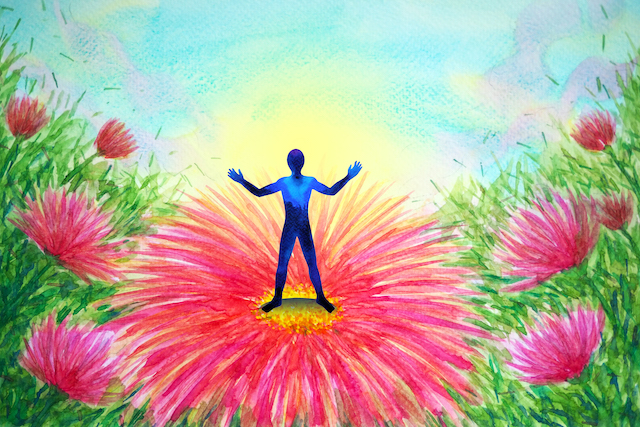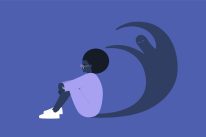
“Being cut off from our own natural self-compassion is one of the greatest impairments we can suffer.” ~Gabor Mate
It was late at night, and I couldn’t sleep. I could almost hear the thudding of fear that was exploding in my chest. I tried to identify the singular cause of the fear, but it didn’t feel like there was just one thing.
There were so many things.
It was the world at large and problems in it; it was how my kid was feeling this morning when they got home from school. It was the rift between my husband and me, feeling so much like I couldn’t reach him to build a connection again. It was work and the state of my health. I was eating too much, always unexercised, ever stressed.
And I could feel that night the icy fear that liked to crawl up my spine and fill me with abject horror.
I just wanted my life to change in so many ways, so I could rid myself of this fear and be over it already.
After this night, and the hundreds of other nights like it where I lay awake unable to sleep, feeling so very bad about my life, I learned something very important. That the fear that existed inside of me was actually very, very old, and it was the same fear that was simply playing on repeat, over all my life. Instead of dealing with the hundreds of things that scared me, I had to go to the source of the fear.
Fear had embedded itself into my bones at an early age, passed on from my parents, and exacerbated by terrifying experiences that I’d had. And it had stayed locked in my body like a confined animal lying in wait, because I had never received enough emotional safety to allow it to release from my body.
Oh, how I hated this fear.
The list of things I was terrified about was overwhelming, and it filled me with such deep shame about who I was now—a grown adult with children, a business, and a husband. That I could be someone who was almost afraid of their own shadow repulsed me.
When I reflect back and think now about that woman, that poor, terrified woman, looking out at the world and feeling so alone in her fear, I feel so much sadness. Not so much about how scared I was—I understand now why I had so much fear in my body and why it stayed there—but because I felt so much shame for feeling that way.
It was like a double whammy of emotional pain—fear in itself is a big, hard, tough emotion to experience day in and day out. And it requires compassion and understanding. Adding deep feelings of shame that, somehow, I was wrong to feel like this, made the fear so much harder to handle.
I yearn to scoop up that woman and hold her and say, “It’s okay. It’s going to be okay.”
What made the difference to that woman lying in perpetual fear and to the woman I am now was that I learned about how emotions actually work. And I learned how to work with emotions so they didn’t stay trapped inside my body, growing ever bigger by the decade, creating a life that kept getting smaller as the fear seemed to have seeped out and tainted so much of it.
I no longer have a growing list of things that scare me. In fact, I have an ever-shortening list of things that scare me, as I have learned how to not just work with the emotion of fear in the present, but to release the gigantic weight of the past fear that I had been carrying.
Decades of fear that had stayed in my body, unable to release and coloring my world view so dramatically.
What really helped me make a huge shift was when I learned to support myself through feeling the emotion of fear. To build a feeling of safety to hold these feelings in my body. To allow them, the sensations they create, in order to be fully present. Feel them and then they have the chance to release.
And this is because our emotions want to be seen, felt, and heard. It may sound illogical, but just because we are feeling emotional doesn’t mean we are actually feeling our feelings.
Most of us, to be honest, are resisting our feelings—trying to move away from them as fast as possible, thinking our way out of them, trying to talk our way out of our feelings or fix the situation/our lives/the people we feel are to blame.
We aren’t accepting them, welcoming them, and allowing them—which is what our emotions want.
When emotions arise, the first thing we need to do, instead of staying on the runaway train of thoughts—the endless cascade of thoughts that all humans have all of the time—is move our attention to our bodies.
We notice: How is the emotion showing up in my body?
What does it look like or feel like?
What sensations am I noticing? Heat, heaviness, tension, constriction?
And when we notice the sensations, maybe the sensations get stronger. I like to think of it like it’s relieved that, finally, we are paying attention to it.
When we aren’t used to paying attention and staying with the sensations of, say, fiery anger or nauseating fear, it can feel like a lot. So we want to be gentle with ourselves, taking baby steps to learn how to tolerate the sensations the feeling is creating in our body. Taking tiny sips of the emotion until we can hold more.
Emotions love to be met with empathy and understanding, so this is my next step. For many of us we have gotten so used to feeling aggrieved or scared by our feelings that we will feel judgment about the feeling being here.
I shouldn’t feel like this!
What’s wrong with me that I get so angry / sad / scared all the time?
Why can’t I just stop feeling so ashamed?!
So, if that’s you, if you load on judgment when you notice your feelings, try this instead.
Offer a pause and some empathy.
Oh, look, fear is here. That’s a tough one for me.
It makes sense that I feel like this.
It’s hard to be with this emotion, but I am going to support myself to feel this.
We can then see what happens when we turn toward that feeling with an attitude of acceptance, understanding, and empathy. How does it respond? What does it feel like to be allowed to have that feeling in your body?
All emotions are natural. All emotions are valid. What makes us human and able to live such rich and rewarding lives and relationships is that we have feelings. When we learn how to fully feel our emotions, we get to become aware of their purpose, their ability to guide us to living and being more authentic in our lives.
Most of us don’t know how to be with the sensations our feelings create, so we get tangled up in how badly we feel about them.
Now, we don’t want to pour our feelings onto people; we don’t want to shout or scare people. But we do want to fully acknowledge our feelings with compassion.
When we can be curious about how we feel, it helps us open up to the possibilities of supporting ourselves through the feelings we are having. And when we offer ourselves compassion, it helps us develop a more trusting, loving, and gentle relationship with ourselves.
Instead of trying to push through or ignore our feelings, when we turn toward them with compassion and empathy, it actually helps us to move through the feeling so much faster.
Once the feeling has been fully felt, when we’ve been able to stay with the sensations that it creates, it will then release.
And when we’ve released that feeling from our body, wow, we feel so much lighter, calmer, with a renewed sense of possibility.
As an added bonus, once our feelings have been seen, felt, and heard, we get to access the part of us that is awesomely productive. The part that’s great at coming up with ideas and solutions, feels confident, and enjoys life. And we have a lot more energy.
When we are able to be with our feelings, understand them, hold them with a feeling of safety and possibility in our body—and once we start doing this over and over again—this is where we get to reduce the amount of fear we hold in our body. And wow, that is a beautiful sensation!
About Diana Bird
Diana Bird is a Neuro Emotional Coach, helping people in Mid-Life escape cycles of panic, dread and overwhelm. Watch her free Masterclass on the one hidden reason why so many people in mid-life end up feeling trapped in these cycles - exhausted but unable to relax, frequently emotionally flooded and feeling like the gas pedal and brake pedals are on at the same time. You'll also learn some powerful tools to unlock true calm and confidence.













 Though I run this site, it is not mine. It's ours. It's not about me. It's about us. Your stories and your wisdom are just as meaningful as mine.
Though I run this site, it is not mine. It's ours. It's not about me. It's about us. Your stories and your wisdom are just as meaningful as mine. 